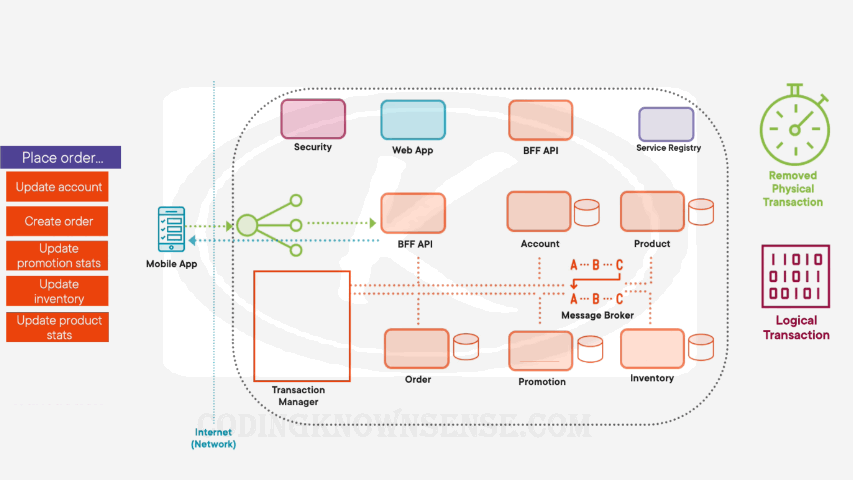Last Updated on October 7, 2023 by KnownSense
In this article, we delve into the role of transaction managers in the context of managing distributed transactions. We explore the significance of transaction managers in ensuring consistency and reliability in complex distributed systems.
Understanding Distributed Transactions
A distributed transaction involves a series of operations on data that span multiple data repositories or components within a system. For example, in an e-commerce application, actions like placing an order trigger a distributed transaction, where various components handle different aspects of the transaction.
Best practices for distributed transactions
Avoiding Physical Distributed Transactions
Physical distributed transactions often entail synchronous communication between different microservices, leading to a request-wait-response pattern. This synchronous approach can result in long wait times for clients, creating issues like temporal coupling. However, asynchronous communication mechanisms, such as message brokers, offer a solution to avoid the challenges posed by physical distributed transactions.
Managing Logical Distributed Transactions
The concept of managing logical distributed transactions involves asynchronous communication, enabling parts of a transaction to progress independently without waiting for the entire transaction to complete. This approach leverages message brokers to facilitate background processing and allows quick responses to client applications.
Transaction Managers

Even with a performant logical distributed transaction, issues can arise if a specific part of the transaction fails. This can lead to partially successful transactions and inconsistent data across the microservices architecture. Transaction managers play a crucial role in managing the state of logical distributed transactions. They receive messages from microservices as each completes its portion of the transaction. If a failure is detected, the transaction manager initiates failure compensation, sending messages to undo the work done in the partially successful transaction. This process restores data consistency. Additionally, transaction managers can cancel specific transactions currently in progress.
Transaction Manager Patterns
Various strategies and patterns are commonly employed to implement transaction managers within microservices architectures. Two prominent patterns are:
- Saga Pattern: The saga pattern ensures that either all operations within a transaction complete successfully, or compensation actions are executed to roll back any previously performed work. It provides a way to maintain data consistency even in the face of partial failures.
- 2-Phase Commit: In a two-phase commit, a controlling node manages most of the logic, while participating nodes (microservices) execute the actions. This approach ensures that all participating nodes agree on the outcome of the transaction, making it either fully committed or fully rolled back.
- Eventual Consistency: A quick example of eventual consistency is a desktop e-commerce application that might need to show an inventory report on screen. As part of this inventory data, we actually need data from two places, from the inventory microservice and some product information, which is actually from our product microservice. So instead of calling two microservices to generate this data, every time the product microservice updates the product name, it actually publishes that information onto a message broker. Our inventory microservice then subscribes to that information and keeps a local copy of all the product names in its local database. The beauty of this approach is not only do we have performance because we’re not having to call two microservices to generate this data, but this is also a decoupled approach. Our product microservice doesn’t really care who picks up these messages regarding the product record updates.
Publishing this data updates as events on our message broker can be done by any microservice for any piece of data, and any other microservice could subscribe to these updates in order to keep a local copy of that data. The other key thing with this approach is that we’re prioritizing availability over consistency. The original source of the data still has the original version of the data in real time, and the version you have might be a delayed copy that you’ve picked up from a queue from a message broker. So it might not be the most recent, up‑to‑date version of that piece of data. But the idea is your duplicate copy will eventually be updated, and your data architecture will be eventually consistent.
Conclusion
Transaction managers play a vital role in managing logical distributed transactions in complex systems. They enable asynchronous processing, handle failure compensation, and offer patterns like the saga pattern and 2-phase commit to ensure data consistency and reliability in microservices architectures. By understanding these concepts and patterns, developers can design robust distributed systems capable of handling intricate transactional scenarios.